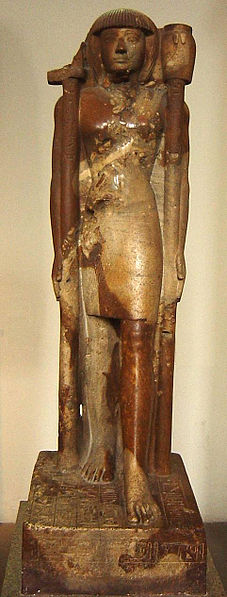Khaemwaset
| Khaemwaset in hieroglyphs | |||||||
|---|---|---|---|---|---|---|---|
Khaemwaset Ḫ3 m W3st He who appeared in Thebes |
|||||||
| Statue of Khaemweset from the British Museum. | |||||||
Prince Khaemweset (also translated as Khamwese, Khaemwese or Khaemwaset) was the fourth son of Ramesses II, and the second son by his queen Isetnofret. He is by far the best known son of Ramesses II, and his contributions to Egyptian society were remembered for centuries after his death. Khaemweset has been described as "the first Egyptologist" due to his efforts in identifying and restoring historic buildings, tombs and temples.
Khaemweset was the second son of Ramesses II and Queen Isetnofret. He was born during the reign of his grandfather Pharaoh Seti I and the fourth son overall. In about the 13th year of the reign of Seti I, crown-prince Ramesses put down a minor revolt in Nubia. Ramesses took his small sons Amunherwenemef and Khaemweset with him on this military campaign. Khaemweset may have been only 4 years old at this time. Khaemweset and his older brother are shown making a charge on the battle field in a chariot. The events were recorded in scenes in the temple at Beit el Wali.
Khaemweset grew up with his brothers during a time of foreign conflict and he is present in scenes from the Battle of Kadesh, the siege of Qode (Naharin), and the siege of Dapur in Syria. In the battle of Kadesh scenes from year 5 of Ramesses II, Khaemweset is shown leading sons of the chiefs of Hatti before the gods. These princes were prisoners of war. In scenes depicting the battle of Qode, Khaemweset is shown both leading prisoners before his father and serving as an attendant of his father. In year 10 of Ramesses II Khaemweset is present during the battle of Dapur.
After this initial period where Khaemweset may have had some military training, or at least was present at the battlefield, he became a Sem-Priest of Ptah in Memphis. This appointment occurred in c. Year 16 of Ramesses II's reign. He would have initially been a deputy to the High Priest of Ptah in Memphis named Huy. During his time as Sem-Priest Khaemweset was quite active in rituals, including the burial of several Apis Bulls at the Serapeum. In year 16 of Ramesses the Apis bull died and was buried in the Serapeum. Funerary gifts were presented by the High Priest of Ptah Huy, Khaemweset himself, his brother Prince Ramesses, and the Vizier Paser. The next burial took place in year 30 and at that time the gifts came from the chief of the treasury Suty and the Mayor of Memphis named Huy. After this second burial Khaemweset redesigned the Serapeum. He created an underground gallery where a series of burial chambers allowed for the burial of several Apis Bulls.
...
Wikipedia

